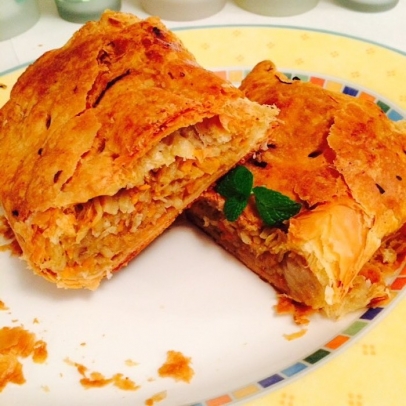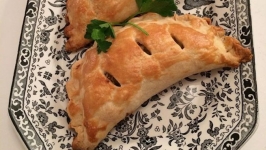Pasties
Seeing empanadas for the first time at Whole Foods, I assumed they were small versions of one of my favorite comfort foods, pasties. I couldn’t wait to bite into one. While empanadas are delicious in their own right, they are not pasties.
Pasties are standard lunchtime fare in Australia and can be traced back to Cornish roots. We Australians have made them our own. We combined raw minced meat, potatoes, carrots, turnip, swede (rutabaga), onion, salt and pepper, encased them in pastry and baked them in the oven. On occasion, my mother prepared pasties, considered a “light” meal and a perfect foil after a massive Sunday roast.
Suspicious that the local butcher was intent on cheating every housewife who stepped over his threshold, my mother didn’t believe in buying beef already ground. Instead she bought a sturdy cut such as round steak, and ground it herself. For many years she made the pastry from scratch, rolling it out to eight-inch circles. She made the mixture, placed about a cup of the raw filling on one side of the pastry and folded the other side over, forming a crescent similar to an empanada. Once sealed, they were baked in the oven. The pasties were served with tomato sauce—that is, ketchup—in our case usually homemade from tomatoes my father grew in our backyard.
Just as people evolve in response to circumstances, so too my mother’s pasties changed. As she got older and her arthritis made kneading and rolling harder, and with commercial puff pastry readily available, she cribbed on the pastry. A food processor replaced her octopus hand grinder at least 30 years before her death at 93.
To keep Mum’s tradition of pasty making alive in Queens, I too had to change my process. The puff pastry available here is either vol-au-vents or packs of two large flat sheets. The sheets are too big for one individual serving but too small to make two normal-sized pasties. Thus, I had to drop the small individual pasties, instead assembling large multi-serving versions. Then my pasties evolved even further. Now they contain root vegetables and no meat, the consequence of vegetarian children.
I’m not complaining. The last time I made a them with meat, I realized I preferred the veggie ones. Then my Sri Lankan/Canadian daughter-in-law declared my pasties “bland.” It was quite a blow. To my mind, these portable powerhouses beautifully preserve the flavors of the vegetables and taste amazing just with a little salt and pepper. Again, I discovered that the new version, which combined traditional Australian vegetables with Sri Lankan spices, was delicious.
My son suggested I throw in some cumin and cayenne. I investigated, uncovering more versions of meat and root vegetables in a pastry case than I could list here. Sri Lanka, with a colonial history so long it has been ruled by the Portuguese, the Dutch and then the English, has its own meat ’n’ potatoes version, called patties. Next time I made pasties I first roasted Sri Lankan spices—chili, cardamom, curry leaves, clove, coriander and cumin —then mixed them into the vegetables.
Each time I bite into one of my pasties I wonder why they have not caught on here. They’re a perfect lunchtime food, the pastry acting like bread in sandwiches making them easy to hold in your hand. Their balance of a small amount of meat with lots of vegetables gives them a healthy twist. I love pasties not because they’re good for me, but because they’re delicious, and I can’t help but wonder what my mother would make of my Queens pasties, and how my future grandchildren will change them in their turn.





